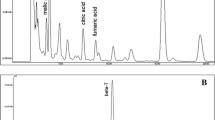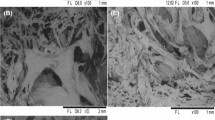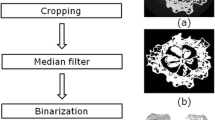Abstract
The effects of air drying temperature on dietary fibre, texture and microstructure of the Cape gooseberry fruits during convective dehydration in the range of 50–90 ºC were investigated. The ratio of insoluble dietary fibre to soluble dietary fibre was higher than 7:1 for all dehydrated samples. At 50 ºC tissue structure damage was evidenced leading to the maximum water holding capacity (47.4 ± 2.8 g retained water/100 g water) and the lowest rehydration ratio (1.15 ± 0.06 g absorbed water/g d.m.). Texture analysis showed effects of drying temperatures on TPA parameters. Changes in microstructure tissue were also observed at the studied drying temperatures. Hot air drying technology leads not only to fruit preservation but also increases and adds value to Cape gooseberry, an asset to develop new functional products.




Similar content being viewed by others
References
Aguilera JM (2005) Why food microstructure? J Food Eng 67:3–1
AOAC (1990) Official method of analysis, 15th edn. Association of Official Analytical Chemists, Washington, DC, USA
Betoret E, Betoret N, Vidal D, Fito P (2011) Functional foods development: Trends and technologies. Trends Food Sci Technol 22:498–508
Borchani C, Besbes S, Masmoudi M, Blecker C, Paquot M, Attia M (2011) Effect of drying methods on physico-chemical and antioxidant properties of date fibre concentrates. Food Chem 125:1194–1201
Borchani C, Besbes S, Masmoudi M, Ali Bouaziz M, Blecker C, Attia H (2012) Influence of Oven-Drying Temperature on Physicochemical and Functional Properties of Date Fibre Concentrates. Food and Bioprocess Technology. Food Bioprocess Technol 5(5):1541–1551.
Chiarini F, Barbosa G (2007) Anatomycal studies of different fruit types in Argentine species of Solanum Subgen. Leptostumonun (Solanaceae). An Jardín Bot Madrid 64:165–175
Chong C, Law C (2010) Drying of Exotic Fruits. In: Jangam SV, Law CL, Mujumdar AS (eds) Vegetables and Fruits. Volume 2, (ISBN - 978-981-08-7985-3, Published in Singapore, pp 1-42.
Di Scala K, Vega-Gálvez A, Uribe E, Oyanadel R, Miranda M, Vergara J, Quispe I, Lemus-Mondaca R (2011) Changes of quality characteristics of pepino fruit (Solanum muricatum Ait) during convective drying. Int J Food Sci Technol 46:746–753
Doymaz I (2008) Convective drying kinetics of strawberry. Chem Eng Proc 47:914–919
Doymaz I, Ismail O (2011) Drying characteristics of sweet cherry. Food Bioprod Proc 89:31–38
Garau MC, Simal S, Rossello C, Femenia A (2007) Effect of air-drying temperature on physico-chemical properties of dietary fibre and antioxidant capacity of orange (Citrus aurantium v. Canoneta) by-products. Food Chem 104:1014–1024
Garcia OE, Infante B, Rivera CJ (2010) Comparison of dietary fibre values between two varieties of cawpea (Vigna UnguiculataL Walp) of Venezuela, using chemical and enzymatic gravimetric methods. Rev Chilean Nutri 37:455–460
Hassanien MFR (2011) Physalis Peruviana: A rich Source of Bioactive Phytochemicals for functional Foods and Pharmaceutical. Food Rev Int 27(3):259–273
Heredia A, Barrera C, Andrés A (2007) Drying of cherry tomato by a combination of different dehydration techniques. Comparison of kinetics and other related properties. J Food Eng 80:111–118.
Karabulut I, Hayaloglu AA, Yildirim H (2007) Thin-layer drying characteristics of Kurut, a Turkish dried dairy by-product. Int J Food Sci Technol 42:1080–1086
Kauffmann SFM, Palzer S (2011) Food structure engineering for nutrition, health and wellness. Proc Food Sci 1:1479–1486
Kaymak-Ertekin F (2002) Drying and rehydrating kinetics of green and red peppers. J Food Sci 67(1):168–175
Krokida MK, Maroulis ZB (2001) Structural properties of dehydrated products during rehydration. Int J Food Sci Technol 36:529–538
Krokida MK, Philippopoulos C (2005) Rehydration of Dehydrated Foods. Drying Technol 23:799–830
Lewicki P, Pawlak G (2005) Effect of Drying on Microstructure of Plant Tissue. Drying Technol 21:657–683
Li L, Wang Z, Hu X, Wu J, Liao X, Chen F, Zhao G (2010) Drying effects of two air-drying shelters in a pilot test on sultana grapes. J Food Proc Eng 33(1):162–178
López J, Uribe E, Vega-Gálvez A, Miranda M, Vergara J, González E, Di Scala K (2009) Effect of Air Temperature on Drying Kinetics, Vitamin C, Antioxidant Activity, Total Phenolic Content, Non-enzymatic Browning and Firmness of Blueberries Variety O´Neil. Food Bioproc Technol 3(5):772–777
Martínez R, Torres P, Meneses M, Figueroa J, Pérez-Alvarez J, Viuda-Martos M (2012) Chemical, technological and in vitro antioxidant properties of mango, guava, pineapple and passion fruit dietary fibre concentrate. Food Chem 135:1520–1526
Miranda M, Vega-Gálvez A, García P, Di Scala K, Shi J, Xue S, Uribe E (2010) Effect of Temperature on Structural Properties of Aloe vera (Aloe barbadensis Miller) Gel and Weibull Distribution for Modelling Drying Process. Food Bioprod Proc 88(2–3):138–144
Oliveira EG, Rosa GS, Moraes MA, Pinto LAA (2008) Phycocyanin content of spirulina platensis dried in spouted bed and thin layer. J Food Proc Eng 31(1):34–50
Peerajit P, Chiewchan N, Devahastin S (2012) Effects of pretreatment methods on health-related functional properties of high dietary fibre powder from lime residues. Food Chem 132:1891–1898
Pinto M, Galvez Ranilla L, Apostolidis E, Lajolo FM, Genovese MI, Shetty K (2009) Evaluation of Antihyperglycemia and Antihypertension Potential of Native Peruvian Fruits Using In Vitro Models. J Med Food 12(2):278–291
Puente LA, Pinto-Muñoz CA, Castro ES, Cortés M (2011) Physalis peruviana Linnaeus, the multiple properties of a highly functional fruit: A review. Food Res Int 44(7):1733–1740
Rahman MS, Al-farsi S (2005) Instrumental texture profile analysis (TPA) of date flesh as a function of moisture content. J Food Eng 66:505–511
Ramadan MF, Morsel J (2003) Oil Goldenberry (Physalis peruviana L.). J Agric Food Chem 51:969–974
Ramulu P, Rao PU (2003) Total, insoluble and soluble dietary fiber contents of Indian fruits. J Food Comp Anal 16:677–685
Salazar MR, Jones JW, Chaves B, Cooman A (2008) A model for the potential production and dry matter distribution of Cape gooseberry (Physalis peruviana L.). Sci Hort 115:142–148
Trinchero GD, Sozzi GO, Cerri AM, Vilella F, Fraschina AA (1999) Ripening-related changes in ethylene production, respiration rate and cell-wall enzyme activity in goldenberry (Physalis peruviana L.), a solanaceous species. Post Biol Technol 16:139–145
Uribe E, Vega-Gálvez A, Di Scala K, Oyanadel R, Saavedra J, Miranda M (2009) Characteristics of Convective Drying of Pepino Fruit (Solanum muricatum Ait.): Application Weibull Distribution. Food Bioprocess Technol 4(8):1349–1356
Vega-Gálvez A, Ah-hen K, Chacana M, Martínez-Monzó J, García-Segovia P, Lemus-Mondaca R, Di Scala K (2011) Effect of temperature and air velocity on drying kinetics, antioxidant capacity, total phenolic content, colour, texture and microstructure of apple (var. Granny Smith) slices. Food Chem 132(1):51–59
Vega-Gálvez A, Puente-Diaz L, Lemus-Mondaca R, Miranda M, Torres MJ (2012) Mathematical modelling of thin-layer drying of Cape Gooseberry (Physalis peru viana L.). J Food Proc Preserv. doi:10.1111/jfpp.12024
Acknowledgements
The authors gratefully acknowledge financial support for this investigation from the Research Department of Universidad de La Serena, Chile.
Author information
Authors and Affiliations
Corresponding author
Rights and permissions
About this article
Cite this article
Vega-Gálvez, A., Zura-Bravo, L., Lemus-Mondaca, R. et al. Influence of drying temperature on dietary fibre, rehydration properties, texture and microstructure of Cape gooseberry (Physalis peruviana L.) . J Food Sci Technol 52, 2304–2311 (2015). https://doi.org/10.1007/s13197-013-1235-0
Revised:
Accepted:
Published:
Issue Date:
DOI: https://doi.org/10.1007/s13197-013-1235-0




